-
Posts
2,284 -
Joined
-
Last visited
Content Type
Profiles
Forums
Gallery
Events
Posts posted by dafi
-
-
After the leechline and bowline blocks had worked out so well, we continued with the tricing lines of the yard tackles pendants.
The block on the yard tackle pendant was hauled to the yard with the outer tricing line and the lower block with hooks was hauled with the inner tricing lines to the shrouds to be hooked/fastened there. Unlike other load rigs, the yard tackles were not struck off when not in use, but were also used as to support the braces in strong winds or for other purposes.
And so that the whole thing doesn't get too boring, this time the blocks are 7" and 8", i.e. 2 mm in my scale. But it doesn't matter, it works just like the other 🙂
First on the filed needle, then stropped in as usual ...
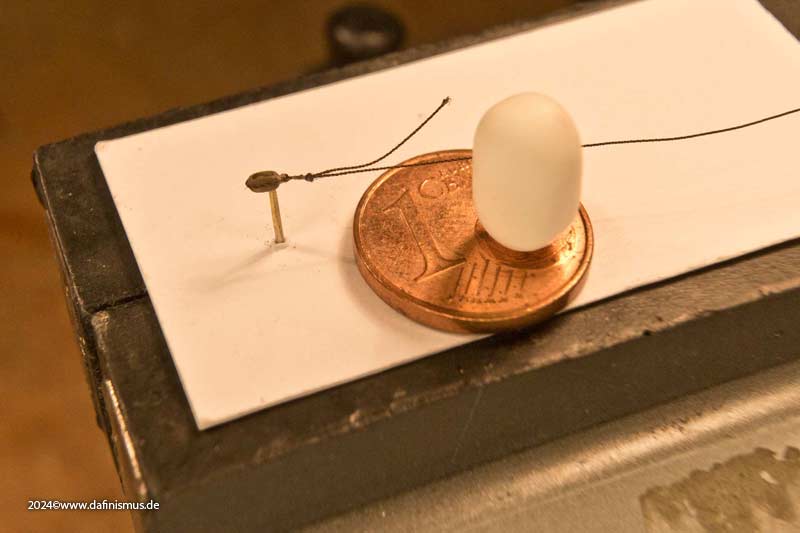
... and succeding the function test.
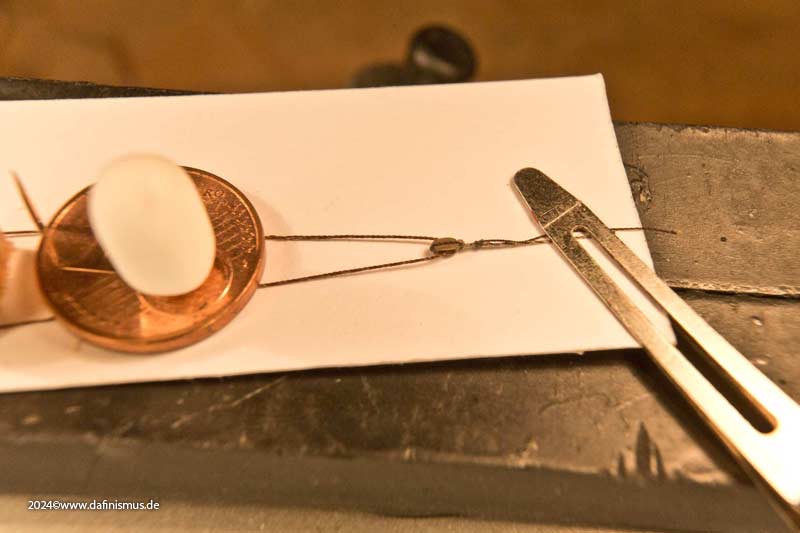
Fits. Then, as usual, tied the eyes with the pointed clamping tweezers and quickly put them all on the leash, such a stopped block is too quickly inhaled.
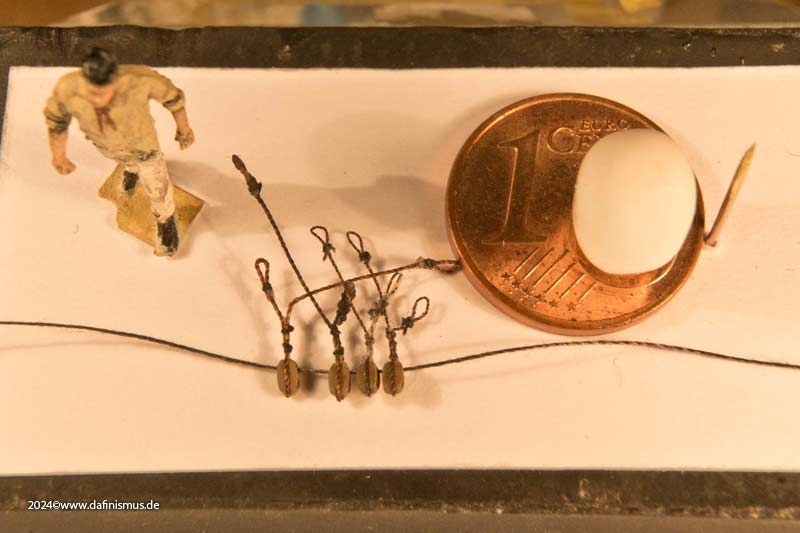
And to show that you can get these blocks to the yard even with sausage fingers like mine ...
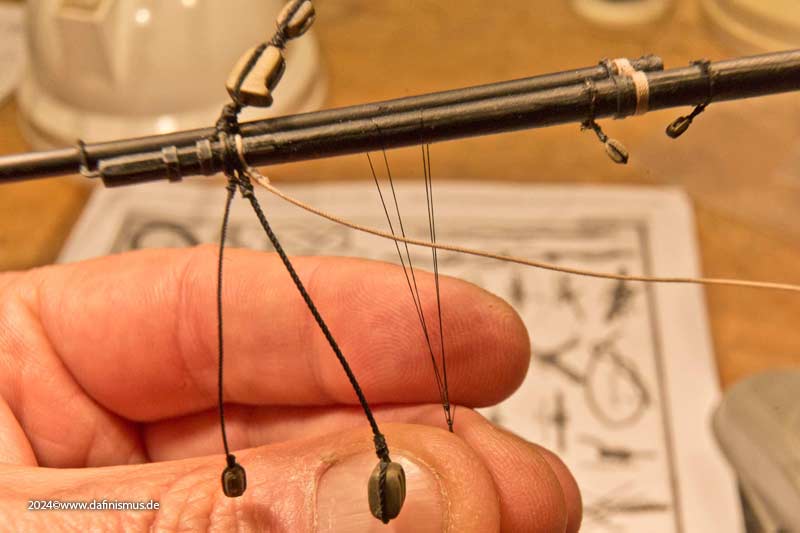
... you just have to make sure that you …
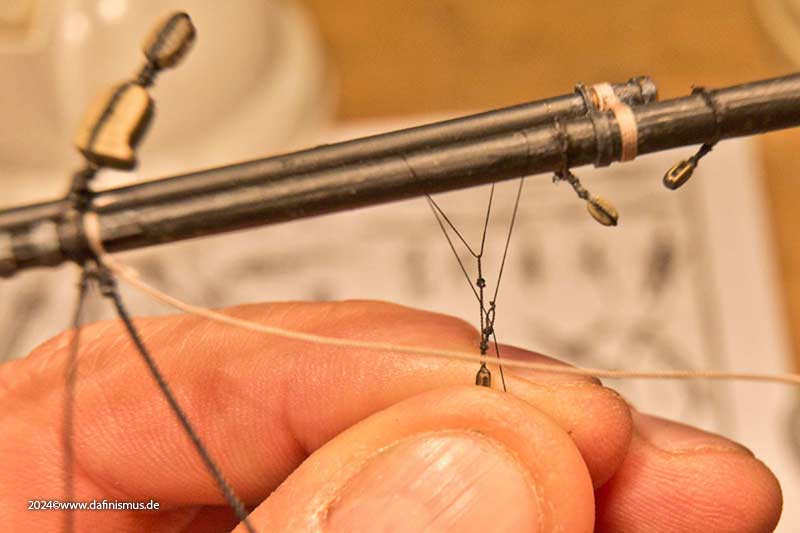
… get not tangled. And already finished.
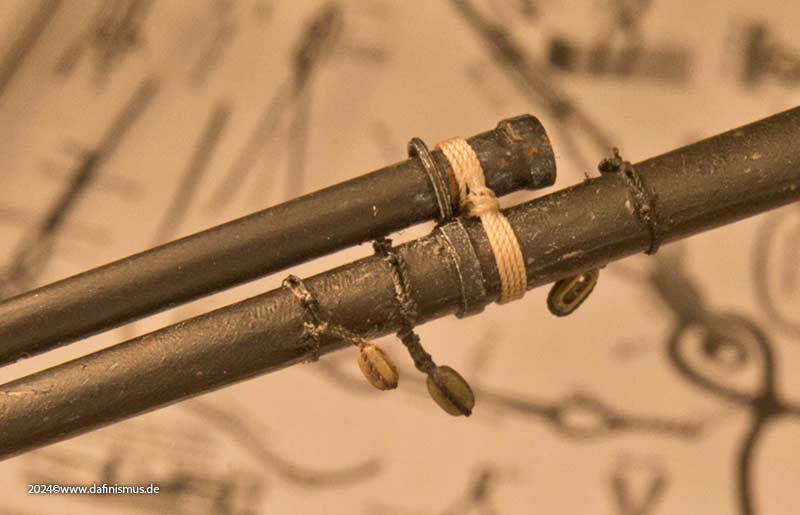
You can clearly see the noticeable difference between the 2 mm block of the tricing line and the 2.5 mm blocks of the leechline.
The tricing line is one of the thinnest in the entire rigging, here hanging loosely with the yard tackle in use ...
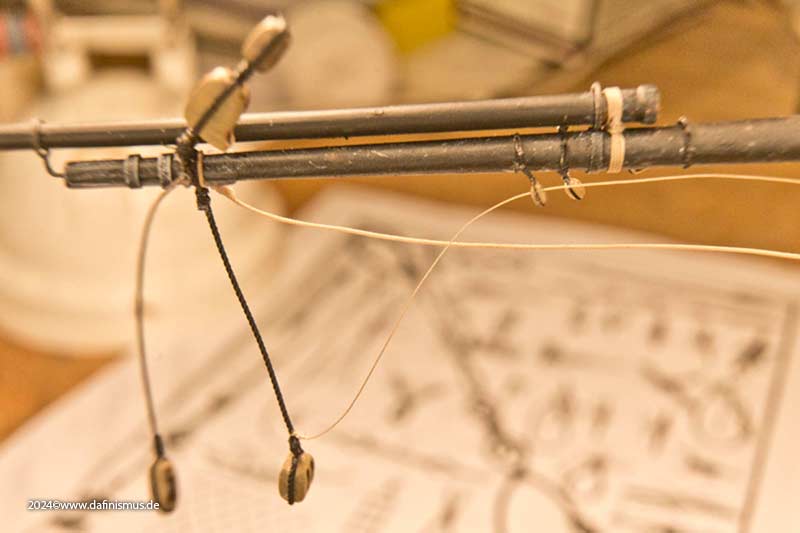
... and with the yard tackle pulled up.
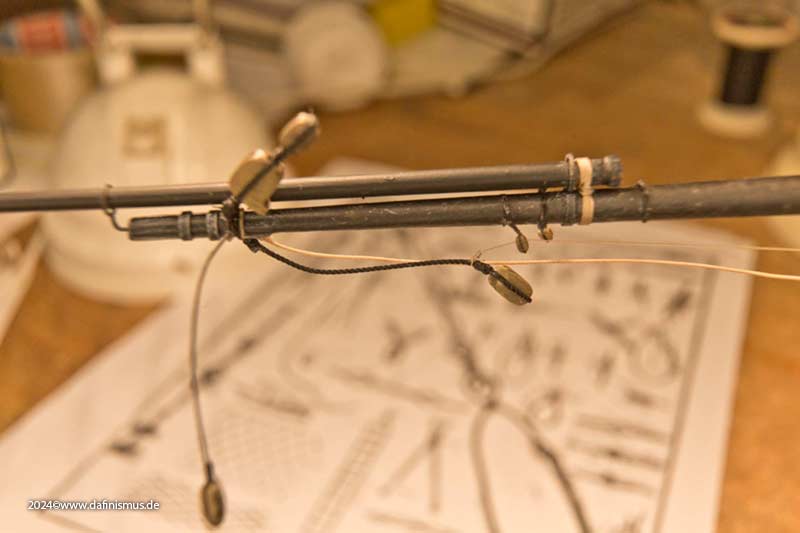
For the sake of completeness, the inner tricing line next to the 4 mm clue line block.
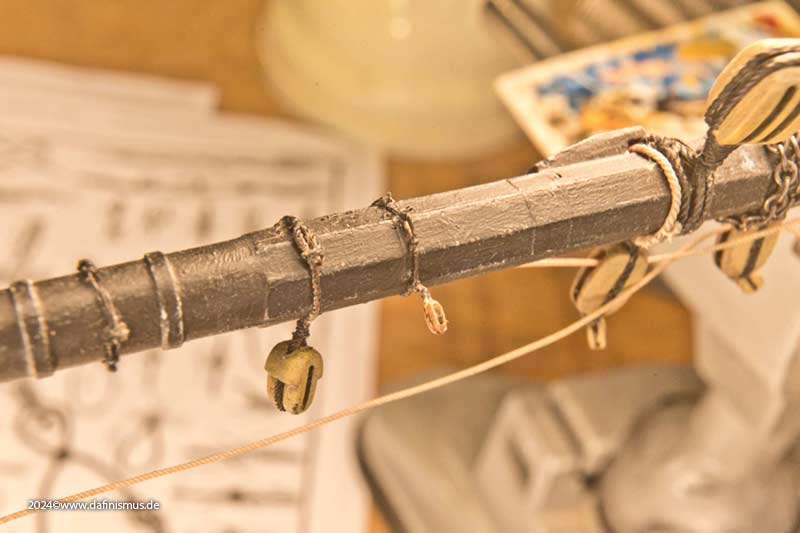
XXXDAn- popeye2sea, 72Nova, Baker and 11 others
-
 14
14
-
8 hours ago, Jim Lad said:
For late 19th/early 20th century, Harold Underhill suggests roughly 3 feet 6 inches for the total finished length of the stirrups.
John
At that times the jackstays were in use, this confirming the length seen on my small scale sailors.
- allanyed, mtaylor and Keith Black
-
 3
3
-
Well, what can I say. I'm only away for a few weeks because of work and already my tinkering room doesn't want to let me back in ...
"What does THIS strange man want here?!" was one of the nicer questions I had to listen to ...
After some persuasion à la "man cave whisperer", I was allowed to do something in there after all. In the meantime, I had revised my lists of blocks for the Victory again. I had noticed that McKay had left out some quite some blocks in the AOTS and that there were also some errors among them. I had therefore plowed through the entire Steel of 1795 and worked through the various entries, compared them and selected the most plausible variant, possibly adding variants. All in all, there were significantly more blocks added, both the standard blocks and the special types. But more on that later.
The last thing I did was to replace the square shoulder blocks, which are used on the ship today and which McKay also shows, with contemporary round ones. The main yard continues to serve as a model playing field. Here is a reminder of the last status.
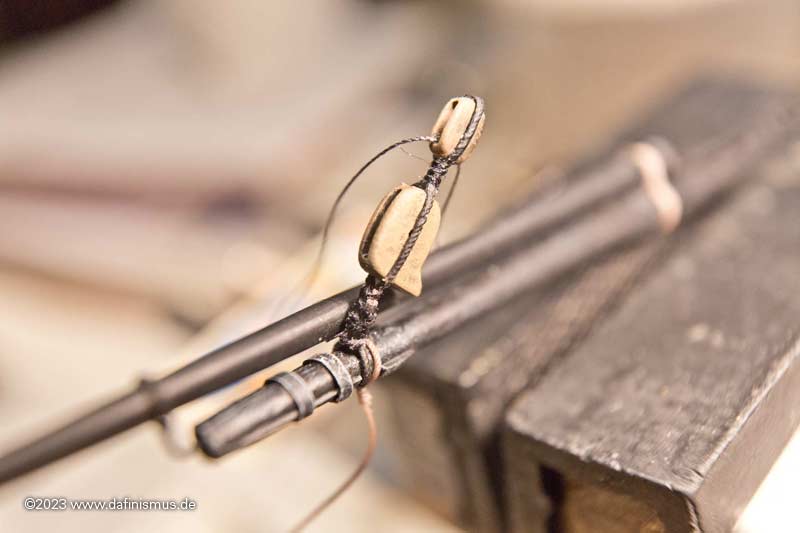
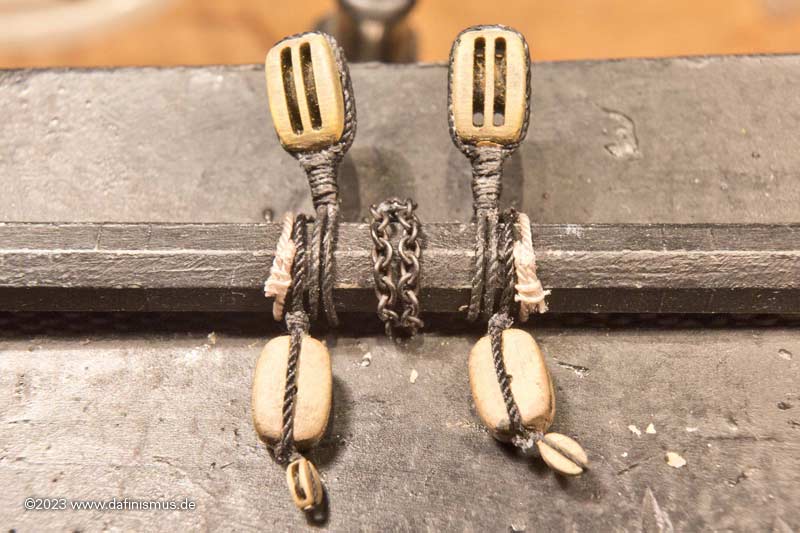
Next came 3 x 2.5 mm blocks on each side for the belly and nock gordings.
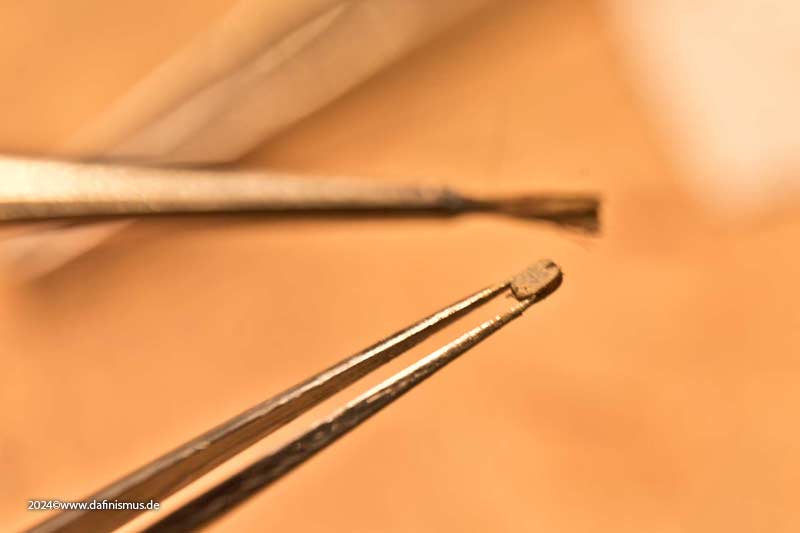
Check on the tweezers whether the paint application is complete and either brush on the tweezers immediately ...
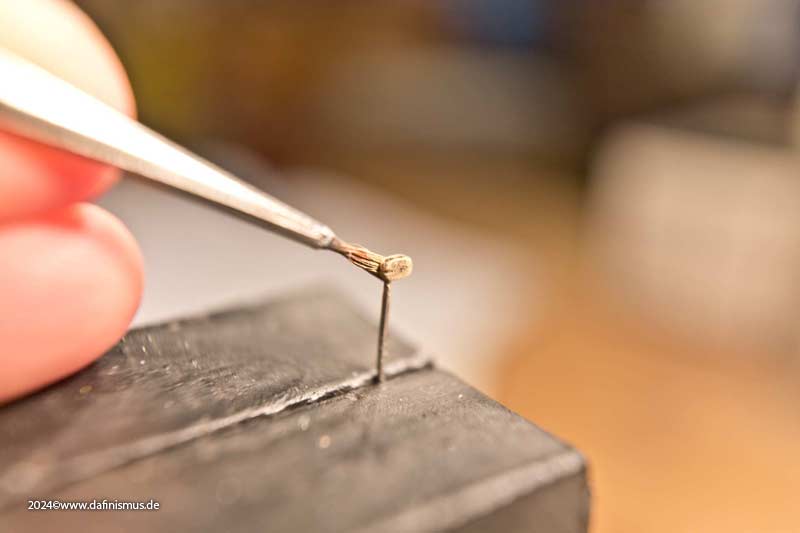
... or after the block has been pinned. Place a strop around the fixed block as described before ...
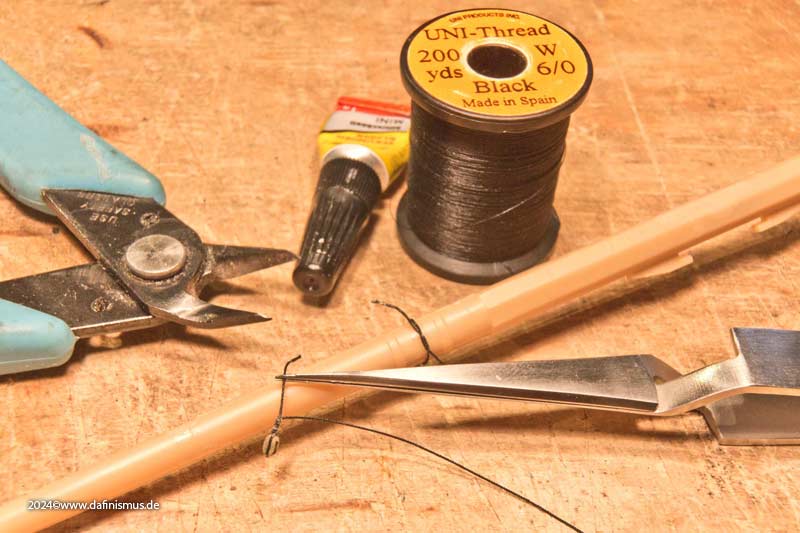
... and checked the length in place. Since the block hangs in front of the yard, the legs must of course be different lengths.
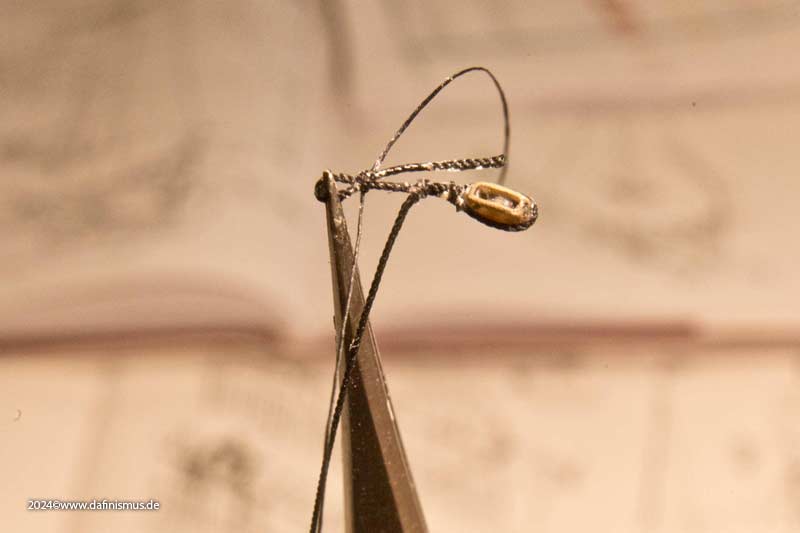
The pointed tweezers with clamping function do a good job here, first one side ...
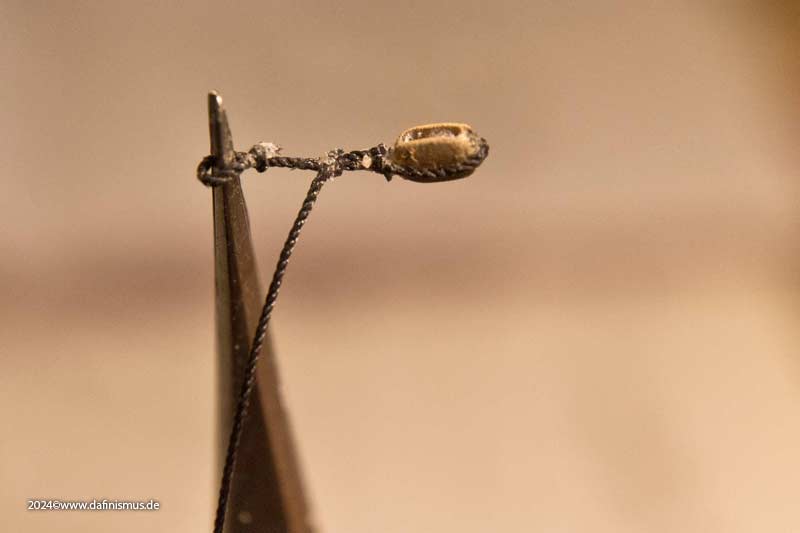
... and neatly trimmed, and the other and you're done 🙂
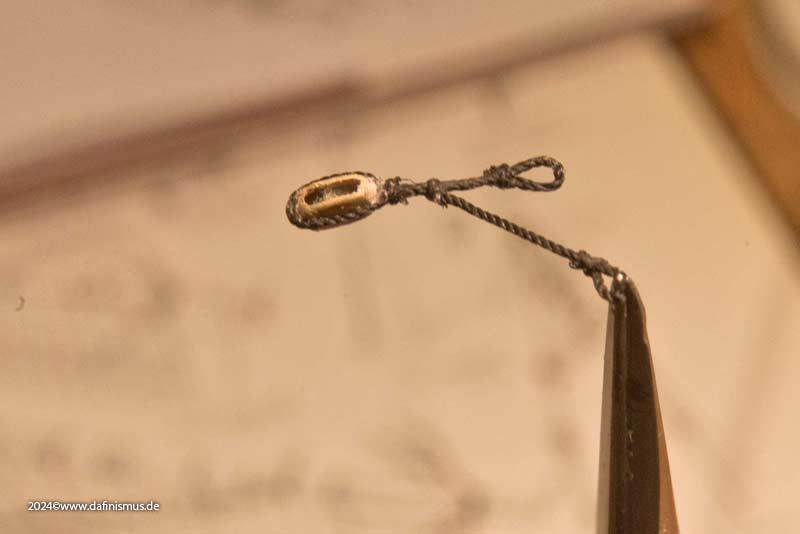
Here is a comparison of the simplified version with a simple knot on the top of the yardarm and the more correct solution with a lashing.
Since the lashing is tricky to thread, a classic needle helps.
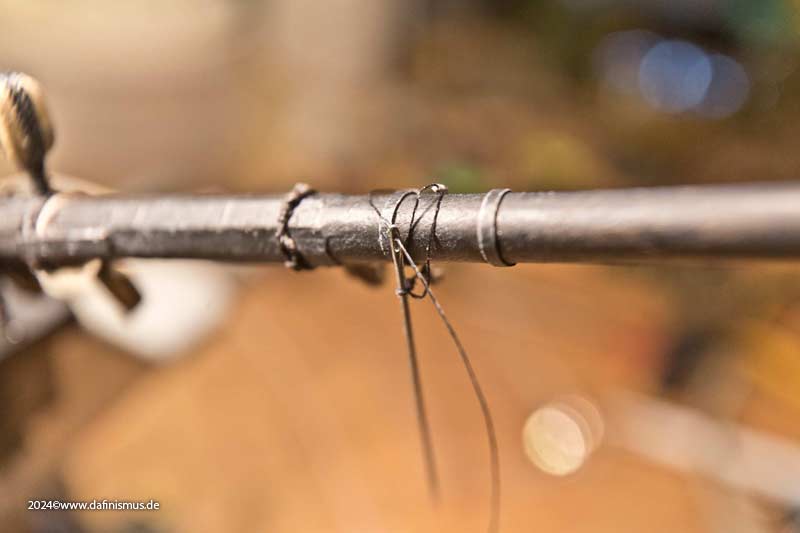
And this is how it should look 🙂
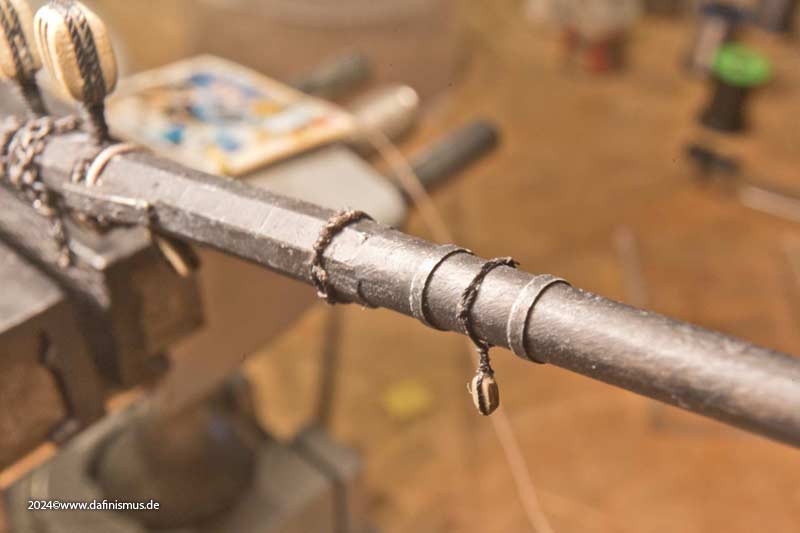
With this technique, I'm now just as fast for the small blocks as I am for the large ones 🙂
XXXDAn -
He is quite tall for the times with 1,80 cm being 71".
XXXDAn
- Gregory, Keith Black and mtaylor
-
 3
3
-
I was most surprised by the stirrups: 3 feet below the yard.
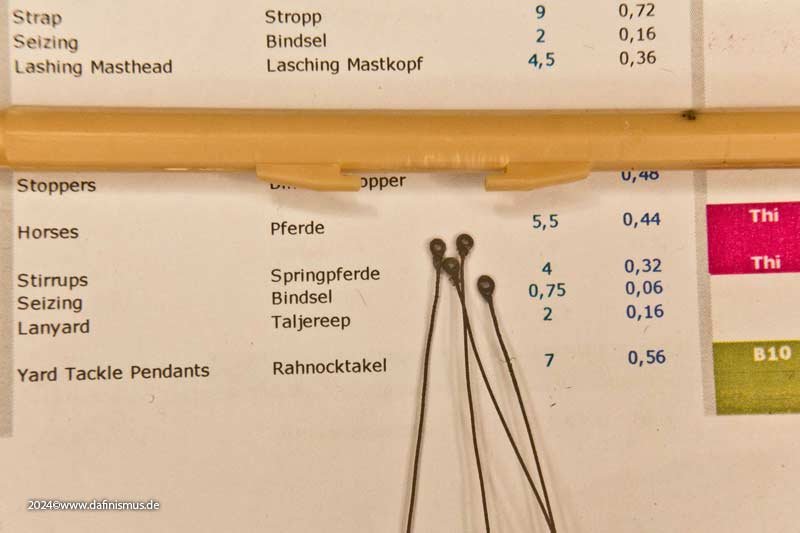
When I held my scale seaman next to it, my suspicions were confirmed: damn deep ...
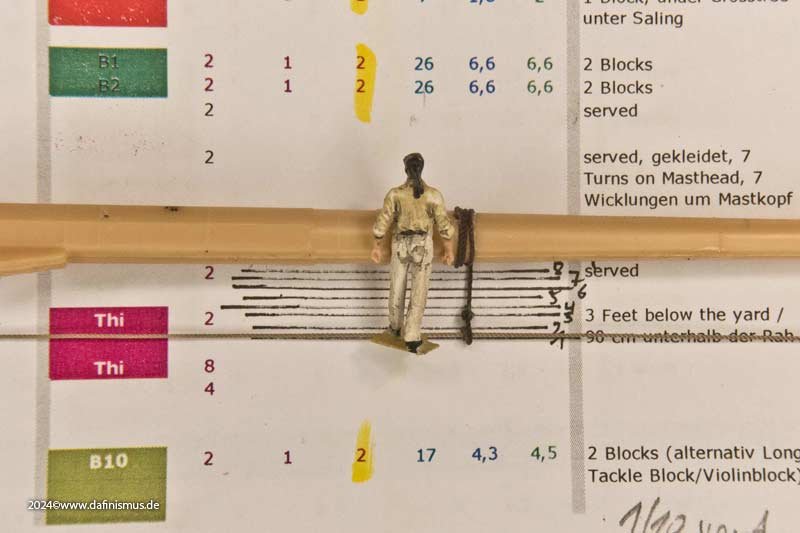
... I would have instinctively hung it 4 mm higher so that my little Able Seaman had a chance of getting over it.
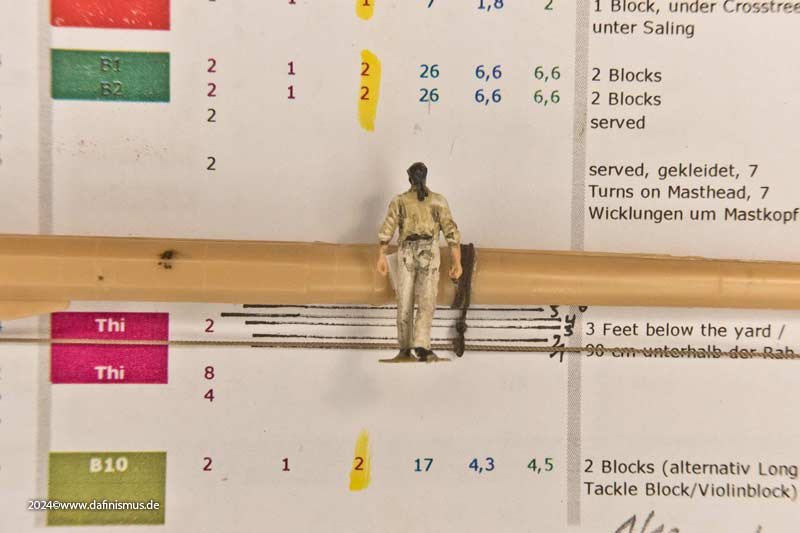
If you add up the 90 cm, the thickness of the yard is up to 60 cm, as in the case of the main yard. That's 150 cm, just under my chin. Then there is also the depth of the yard to consider, so that in addition to the 90 cm length under the yard, there is also approx. 0.5 x the diameter of the yard. Another escalating factor is that the horse can sag quite a bit in the middle between two stirrups.
To be able to judge this better, I trained two Able Seamen, one for the thickest part of the big yard with a diameter of 60 cm and one for the yardarm with a diameter of 30 cm.
First the variant with 3 feet under the yard. The sailor on the thick yard has very bad cards. The tar jacket on the thin end fits better.
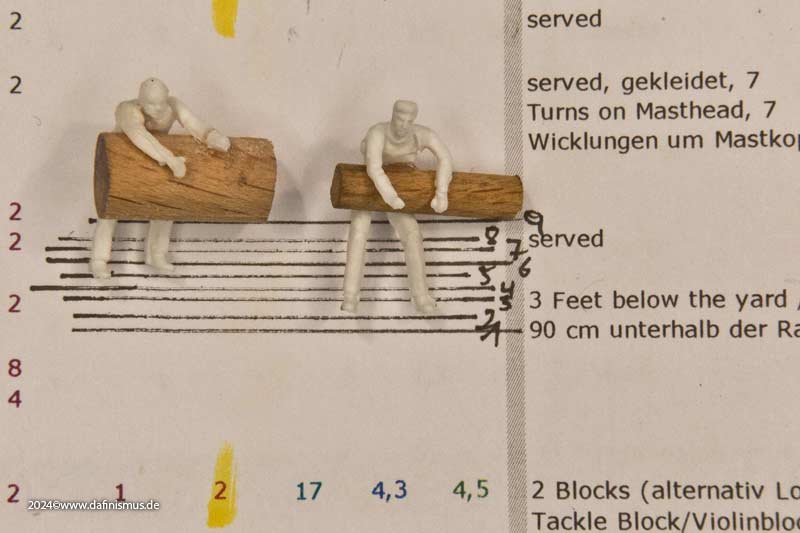
If I refer the 3 feet to the center of the yard, it's better.
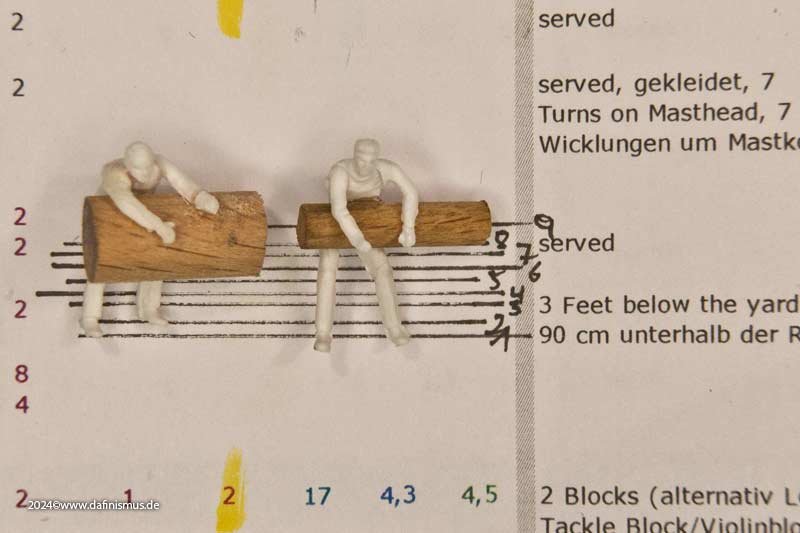
If you relate the 90 cm to the upper edge of the yard, it fits best. Here the sailor has the opportunity to use the horses at the thick point, the colleague on the outside still hangs at a similar height.
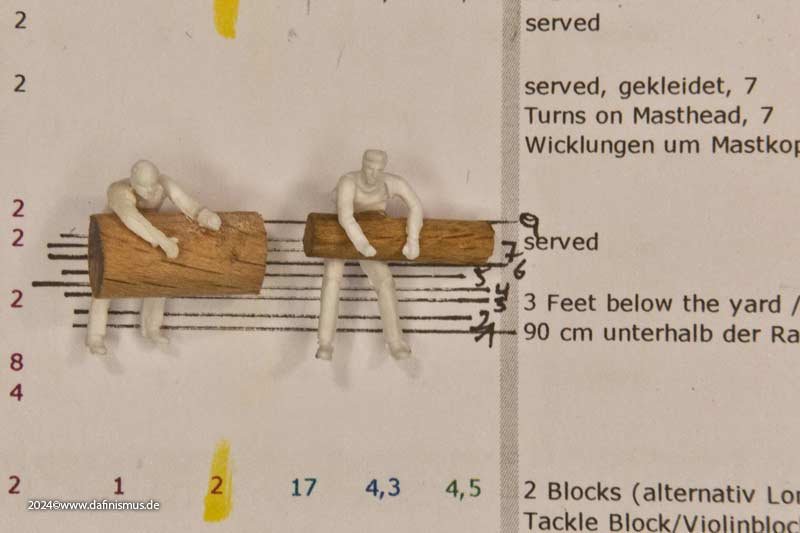
To confirm this interpretation of Steel's specification I had a closer look from the side.

The red part of the stirrups is about 3 Feet and it looks perfect both for the simply standing on it as for the working in a upswung position.
If one takes the other descriptions the remarks to the simplyfied "3 feet underneath the yard" it would possibly read like this:
Stirrup long 3 Feet, nailed to the top of the yard, with enough overlength to do 3 turns around the yard. Hangs behind and underneath the yard.
Could this interpretation be correct?
XXXDAn- mtaylor, dvm27, Thukydides and 3 others
-
 6
6
-
For the blocks of my Victory I had to work my way through David Steel's The Art of Rigging. Originally, I had oriented myself on McKay's AOTS, but then realized that there was still a lot omitted and there were also some errors.
Steel is much more detailed, but there are some ambiguities as well as differences to other sources. Here are a few that I am working on and wondering about 🙂
- Keith Black and mtaylor
-
 2
2
-
This is still the time of no uniform for the seaman 🙂 Preferred color blue and white, but not as uniform but as the purser usually bought larger stocks of cloth to be sold at the sailors and therefor som uniformity came into the game. But on the other hand plenty sailors wore their privat cloths, thus giving all shades of contemporary colors.
Marines were more disciplined in that sense, sometimes were more regulated, as were the midshipman and officers.
XXXDAn
-
Great work.
Interestingly, when comparing McKay + Longridge with Steel, I noticed that Steel replaced most of the long tackles with normal double blocks. Only not those on the forestays, which are still listed there as with long tackles.
I usually fix the fall with a half hitch between block and hook and, depending on the situation, either wrap the overlength in a bunch or wrap the rest around the fall, which I would do on the stays.
XXXDAn
- Ian_Grant and Malcolm Brown
-
 2
2
-
-
Hello William,
congratulations for your persistence and the want to learn!
If this is the mizzen mast the Slice is right, if this is the main or fore mast then the pendants should be looped over the masthead in a pair like the shrouds do. Here a cutout from Peterssen.As for the blocks, McKay apparently omitted them - as it was for many years on the V. in P. Steel is using Single 24 Inch for main and fore (15 and 36 in AOTS and the spreadsheet that I did send), and 11 inch for the mizzen. Also for Runner and fall that are hooked in there Steel uses normal single and double blocks, as for most of the literature there are long takle blocks mentionend.
For your build there is a sprue in the standing rigging section called "Pendants of Tackles" 015-036with enough good blocks of the said size. Also the 11 inch for the mizzen and topmasts can be found there 🙂
I added a PDF with an overview which blocks to be found on what sprue, hope it helps.
I did some more crosschecking on the matter of blocks and added some more blocks to fit for different rigging sources. All those that already did purchase blocks, there will be a new version of the spreadsheet and free "extension set" coming soon 🙂
XXXDAn
-
-
Do not worry - looking great!
XXXDAn
-
Just a small warning for those who follow the sequences of my build: Please remember to put the shrouds before putting up the stays! My stays are up for test purposes, I will still have to reopen the lanyards take the stays off, fit pendents and shrouds and then finally reset the says and its lanyards 🙂
All the best, DAniel
-
Just a small warning: Before the main- and forestay can be set, do not forget to put up the shrouds!
XXXDAn
-
Well done 🙂
For the blackening: I usually take a dry brush with black paint and go over it after assembly. Takes out all injuries in the blackening from the tools, adjustes the color and blends in with the other paints and also covers all possible white spots fron the CA 🙂
XXXDAn
-
Wonderfully done! Congrats!
Please allow me a remark: The 3rd boobstay that splits into two legs is not the optimal solution. It is shown in Longridge and other literature, also it was featured for many years on the exhibut in P. The preferred solution would be to be fixed in a new hole just underneath the upper two ones.XXXDAn
-
3 hours ago, Blue Ensign said:
The final interesting feature for detail fans is the knot secured on the Mizen channel.
This is the reason at the time I wanted to look over the Poop.
The knot secures the Rudder pendant which attaches to the chains and is used to control the rudder should the tiller lines be shot away.
Hello B.E.
wonderful work, as always from you! Just rediscovered this thread and enjoyed your astounishing work.
Small remark/question for the knot in the channel from fixing the the rudder pendants. In the most probably contemporary model of Victory LR0512 http://collections.rmg.co.uk/collections/objects/66473.html the pendants do not stop there but run through the channel boards up to the poopdeck to be secured on a clamp there. Is there a contempoprary source that indicates where the pendants were usually led to?
Also concerning the small leather tube that protects the port lid lanyard: I had it alraedy in one of my models faked by a bit of white glue to give volume and a bit of black paint. looked convincing at my small scale.
All the best, Daniel
- chris watton, mtaylor, Theodosius and 1 other
-
 4
4
-
-
Yes, dafi knows how to do it, dafi hasn't forgotten anything ...
...
...
... the wrecking ball!
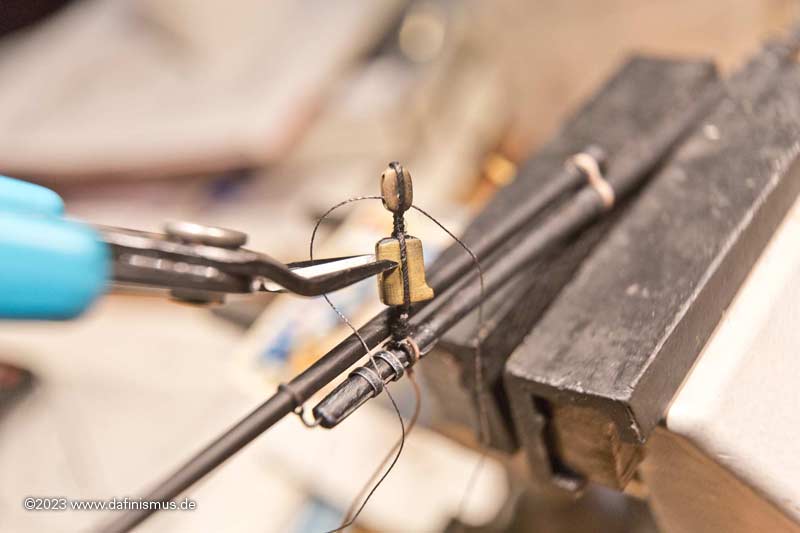
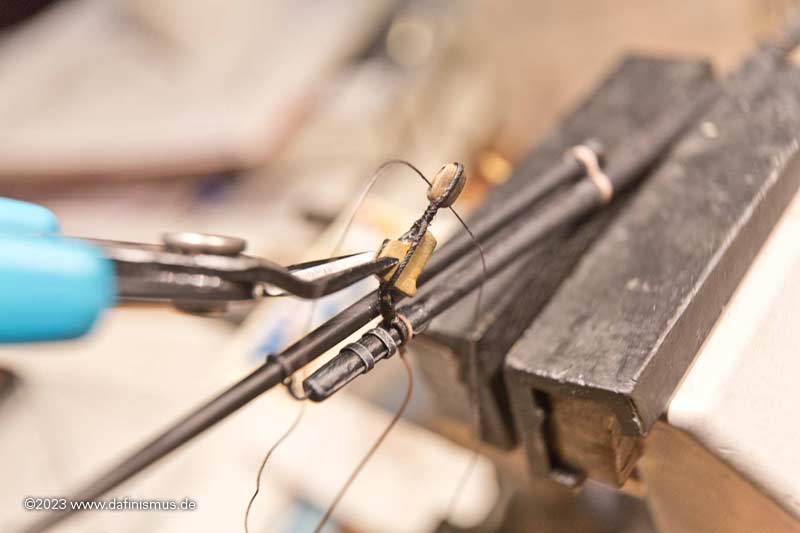
What happened again?
I always say it, my biggest problem is getting the big exhibit in P. out of my head.
For almost 20 years now, I've been looking forward to those great special shoulder and quarter blocks that I discovered back then back there, building them exactly according to McKay and Bugler's plans and, in my exuberance, not even realizing that they are much rounder in the classic literature ...
Thank goodness there are some people in my german pack and also here in the MSW who are not so obsessed and have a keen eagle eye and have pointed this out to me. Thank you!
So I made new rounder blocks. I used this too to do some more research, as I was slightly irritated at the first pass when I noticed that these blocks on the foremast lower mast and topsail are all the same size, just like on the main mast lower mast and topsail. Thanks to you @druxey for reassuring me in theses sizes and confirming this on the basis of Steel's information.
At this point, in response to a few questions, I would like to repeat the painting method: first, using an old disheveled brush, two layers of very thin paint in a darker brown, which is the base color. The thin paint makes it easy to get to the sides without pasting over the holes.
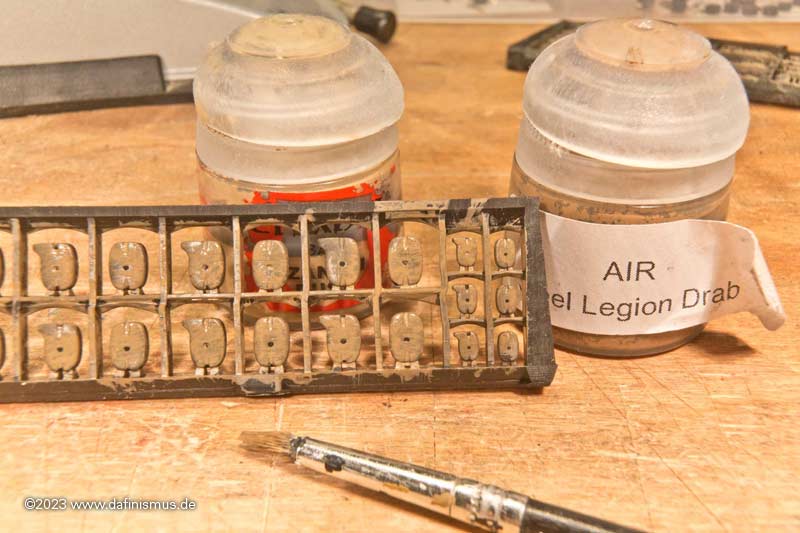
The highlighting color in a lighter brown, applied with a dry brush, is applied on top. This emphasizes the edges and the depths remain slightly darker, which gives optical depth. And the deliberately uneven application of color keeps the whole thing alive and no longer looks like plastic.
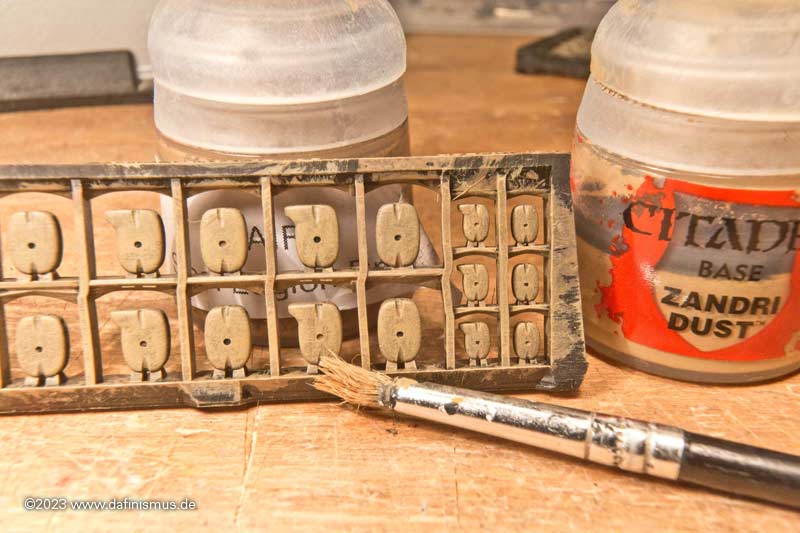
Then the grand finale: as the new round blocks are the same size as the old square ones, simply press the new ones back into the strop from the side and you're done.

The same with the sheet quarter blocks, before - after http://www.shipmodels.info/mws_forum/images/smilies/icon_smile.gif
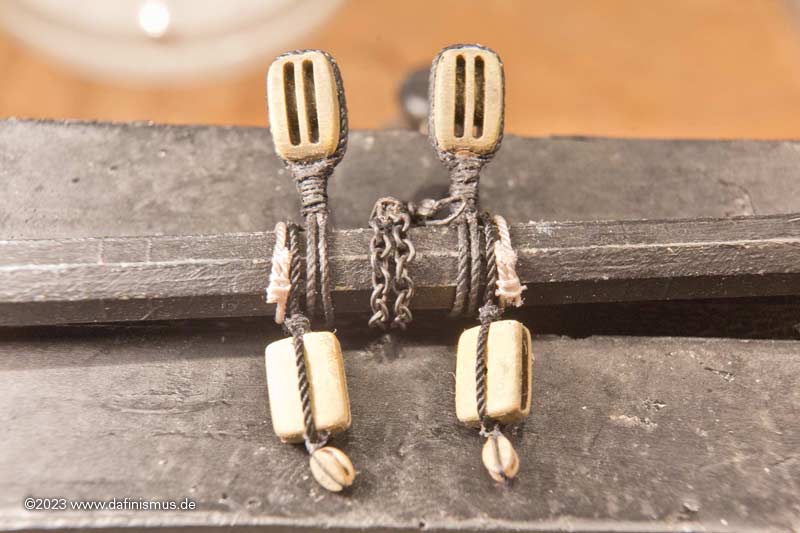
You see dafi still can do it http://www.shipmodels.info/mws_forum/images/smilies/icon_wink.gif
XXXDAn
PS: All those of you that already got a delivery of blocks will get a free upgade of the blocks in question http://www.shipmodels.info/mws_forum/images/smilies/icon_smile.gif -
Now I got, it Allan 😊
Bill is still at the hearts for boopstay and bowsprite shrouds.
You are right, the lower hearts for main and forestay are different as the collars for the mainstays are single ones and the ones for the forestays are taken double.Here is the fixing of the Stays in my Model, the bowsprite gear is aready fixed.
-
The old Warthog 🙂
Just a comment for the collars of the hearts. Even though some assembly instructions indicate all 3 Harts together in 1 collar, it schould be 1 collar for each single heart, means 7 altogether. This is historically correct and believe me, even for the model building much easier than fitting all in 1 collar while levelling out the lengths properly 🙂
XXXDAn
-
Next, of course, was the combination of blocks with a shoulder block for the top sail sheet and a normal block for the lift on the yardarm.
First the two blocks stropped together ...
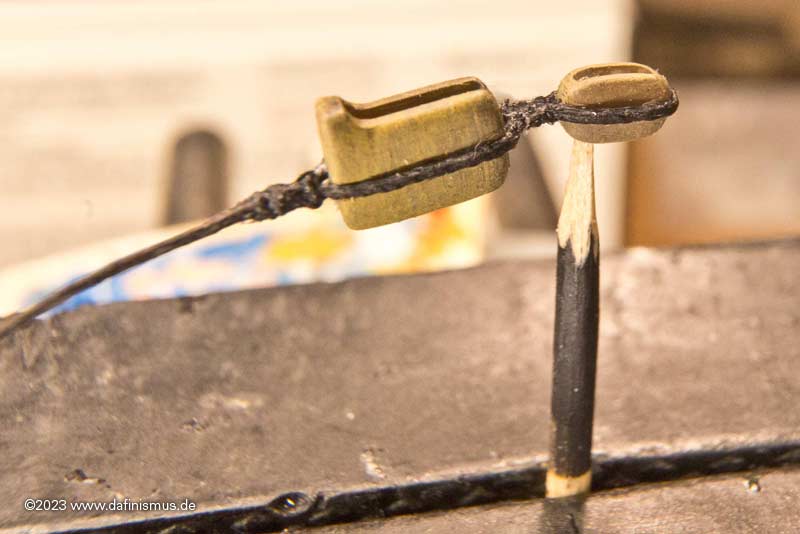
... then still smuggled in with bright rope the loop for the horses onto the cleat and finally tied in the eye for the double block at the outside.
First one side ...
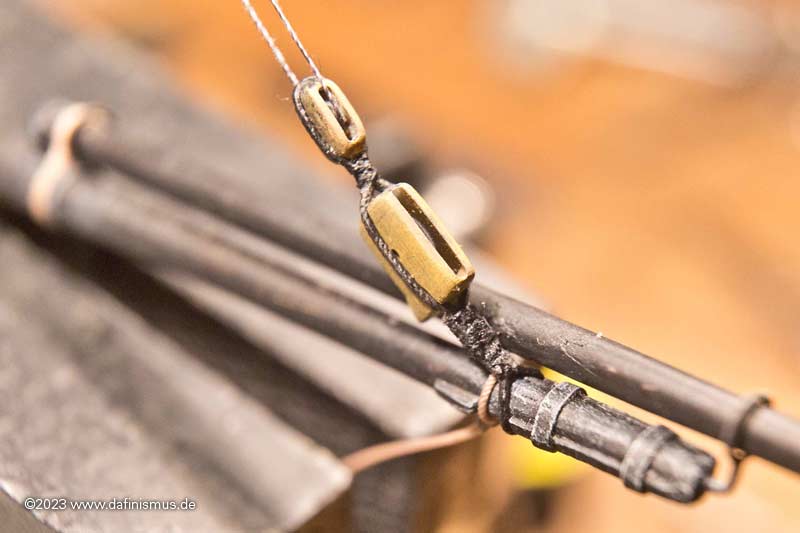
... and then the second ...

... and everything for the lifts is on the yardarm 🙂
XXXDAn -
I've been busy lately and haven't had much time to tinker. But the list of blocks to be used on the Vic and the corresponding rope thicknesses has finally been finalized. Time to check some of them out. As the blocks are sorted by yards and other locations, here is the block set for the main yard.

Since the main yard has already been started, I've taken on its lifts. First the hangers. As usually served with white glue and black paint.
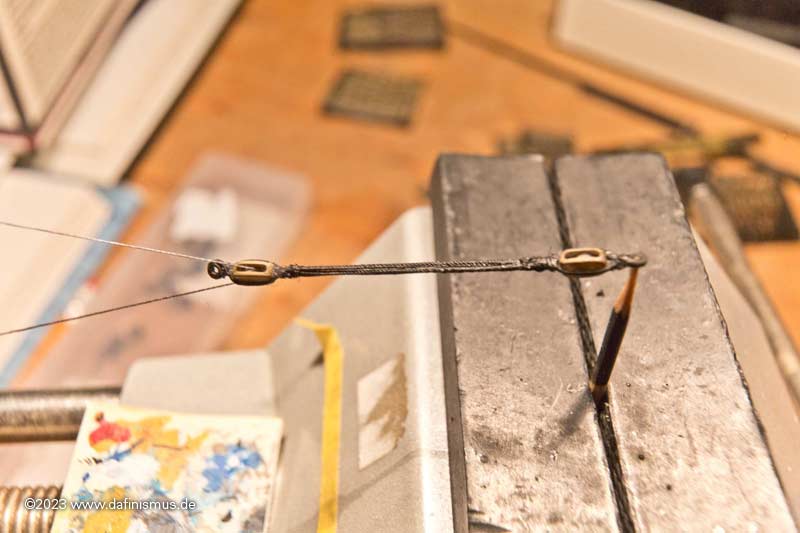
The loop underneath the cap that holds the hanger together.
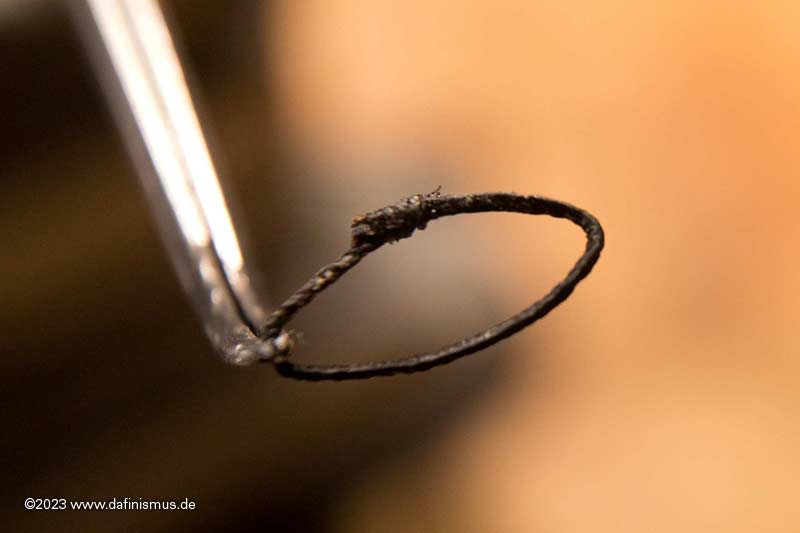
And here the assembly on a spare mast cap.
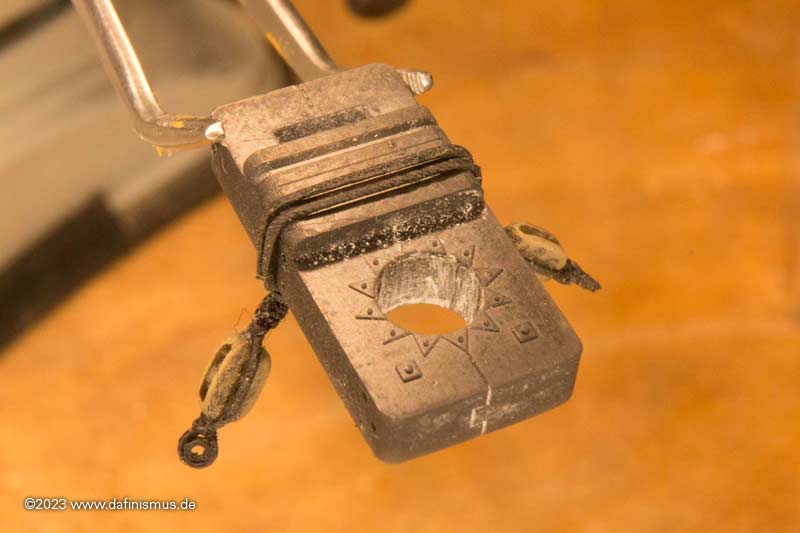
More hopefully soon.
XXXDAn -




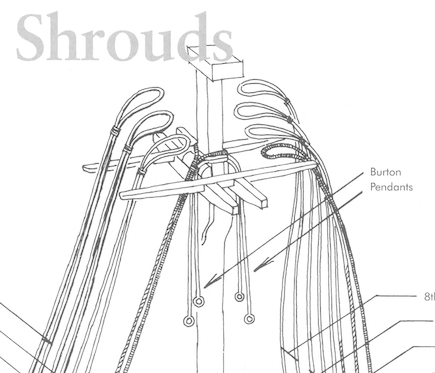

David Steel's The Art of Rigging: Juxtapositions, analyses and the yet unknown
in Masting, rigging and sails
Posted · Edited by dafi
Another difference I noticed are the yard tackle blocks and the braces pendants.
Steel mentions that the pendants of the braces of the main yard*** were 1/10 of the length of the yard. In the navy they were sometimes operated without pendants, i.e. the block was lashed directly to the yardarm.
In this matter, one probably has the freedom, as long as no direct references can be found in the logbooks. Are there any hints for that? @Morgan
It is interesting to note that Steel has replaced many long tackle blocks with normal double blocks. In particular, the stay tackle blocks and the yard tackle blocks are equipped with 17" double blocks instead of 24" long tackle blocks. More stable blocks or simplification of the material list? Or signs of the beginning machine milling of blocks? All other sources speak of violin blocks for the entire time frame.
Steel also gives the length of the pendants of the yard tackle blocks as 1/10 of the yardarm length. In many other sources I have the impression that the pendants extend to the fishing in the middle of the yard, i.e. they were about twice as long.
The two different versions are shown opposite each other in the picture.
And how could it be otherwise, questions upon questions ...
XXXDAn
*** The brace pendants of the foresail are 1/8 of the yard length according to the Steel